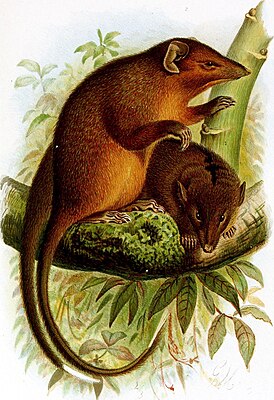Narrow-striped pouch mouse
| Narrow-striped pouch mouse | ||||||||||||
|---|---|---|---|---|---|---|---|---|---|---|---|---|

Narrow-stripe striped pouches, drawing from the annals of the Natural History Museum of Genoa |
||||||||||||
| Systematics | ||||||||||||
|
||||||||||||
| Scientific name | ||||||||||||
| Phascolosorex dorsalis | ||||||||||||
| ( Peters & Doria , 1876) |
The narrow-striped pouch mouse ( Phascolosorex dorsalis ) occurs in the mountains of the island of New Guinea.
Subspecies and distribution
There are three subspecies:
- Phascolosorex dorsalis dorsalis , the nominate form , lives in the Arfak Mountains in the north of the Vogelkop peninsula ,
- P. dorsalis brevicaudata occurs in the Weyland Range in the west of the province of Papua and
- P. dorsalis brevicaudata in the Central New Guinea Mountains ( Maoke Mountains and Bismarck Mountains ), as well as in the mountains of the Huon Peninsula .
features
Males of the narrow-striped pouch mouse have a head-trunk length of about 16.5 cm, a 15.5 cm long tail and can weigh up to 132 to 145 g. Females stay a little smaller with head and torso lengths of around 11.5 to 13.5 cm and tail lengths of 11.5 to 14.5 cm. These data were collected in the west of the distribution area. The animals in the east are much smaller. Males reach a weight of 43 to 73 g, females weigh 36 to 54 g.
Characteristic and eponymous for the genus is a dark stripe on the back, through which the animals can be distinguished from all other pouch mice from New Guinea. The stripe is significantly narrower than that of the red-bellied striped bag mouse ( Phascolosorex doriae ) and the narrow-striped striped bag mouse is also significantly smaller than its sister species . The belly of the animals is reddish. The back hairs of the animals living in the west often have whitish tips, in the animals occurring in the east this feature is found far less often.
Way of life
The narrow-striped pouch mouse lives in the New Guinea mountains in cloud forests at altitudes of 1500 to 3600 meters. It is probably diurnal and primarily ground dwelling. Mainly spiders and insects serve as food. Small vertebrates (frogs and small mammals) are also eaten. Narrow-striped pouch mice breed all year round. Births usually take place nine months apart. The females have four teats in their pouch.
The narrow-striped pouch mouse is listed by the IUCN as not endangered (least concern) because it is widespread and the population is high in the entire distribution area.
Individual evidence
- ↑ a b c Andrew Baker: Family Dasyuridae (Carnivorous Marsupials). Page 299 in Don E. Wilson , Russell A. Mittermeier : Handbook of the Mammals of the World - Volume 5. Monotremes and Marsupials. Lynx Editions, 2015, ISBN 978-84-96553-99-6 .
- ↑ Phascolosorex dorsalis in the Red List of Threatened Species of the IUCN 2016. Posted by: Woolley, P., Leary, T., Seri, L., Flannery, T., Wright, D., Hamilton, S., Helgen, K. , Singadan, R., Menzies, J., Allison, A., James, R., Aplin, K., Dickman, C., Lunde, D. & Bonaccorso, F., 2015. Retrieved March 9, 2018.
